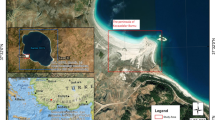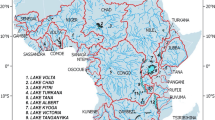Abstract
In this study, an improved Moderate-Resolution Imaging Spectroradiometer (MODIS) ocean chlorophyll-a (chla) 3 model (IOC3M) algorithm was developed as a substitute for the MODIS global chla concentration estimation algorithm, OC3M, to estimate chla concentrations in waters with high suspended sediment concentrations, such as the Yellow River Estuary, China. The IOC3M algorithm uses \( {{{\left[ {R_{\text{rs}}^{{ - 1}}\left( {{\lambda_{{1}}}} \right) - {k_1}R_{\text{rs}}^{{ - 1}}\left( {{\lambda_{{2}}}} \right)} \right]}} \left/ {{\left[ {R_{\text{rs}}^{{ - 1}}\left( {{\lambda_{{3}}}} \right) - {k_{{2}}}R_{\text{rs}}^{{ - 1}}\left( {{\lambda_{{4}}}} \right)} \right]}} \right.} \) to substitute for switching the two-band ratio of max [R rs (443 nm), R rs (488 nm)]/R rs (551 nm) of the OC3M algorithm. In the IOC3M algorithm, the absorption coefficient of chla can be isolated as long as reasonable bands are selected. The performance of IOC3M and OC3M was calibrated and validated using a bio-optical data set composed of spectral upwelling radiance measurements and chla concentrations collected during three independent cruises in the Yellow River Estuary in September of 2009. It was found that the optimal bands of the IOC3M algorithm were λ1 = 443 nm, λ2 = 748 nm, λ3 = 551 nm, and λ4 = 870 nm. By comparison, the IOC3M algorithm produces superior performance to the OC3M algorithm. Using the IOC3M algorithm in estimating chla concentrations from the Yellow River Estuary decreases 1.03 mg/m3 uncertainty from the OC3M algorithm. Additionally, the chla concentration estimated from MODIS data reveals that more than 90 % of the water in the Yellow River Estuary has a chla concentration lower than 5.0 mg/m3. The averaged chla concentration is close to the in situ measurements. Although the case study presented herein is unique, the modeling procedures employed by the IOC3M algorithm can be useful in remote sensing to estimate the chla concentrations of similar aquatic environments.






Similar content being viewed by others
References
ASD (1999). Analytic Spectral Devices, Inc. Technical Guide, 3rd Ed.
Bailey, S. W., & Werdell, P. J. (2006). A multi-sensor approach for the on-orbit validation of ocean color satellite data products. Remote Sensing of Environment, 102, 12–23.
Carder, K. L., Chen, F. R., Lee, Z. P., Hawes, S. K., & Cannizzaro, J. P. (2003). Case 2 chlorophyll-a. MODIS Ocean Science Team Algorithm Theoretical Basis Document.
Casal, G., Kutser, T., Domingue-Gomez, J. A., Sanchez-Carnero, N., & Freire, J. (2011). Mapping benthic macroalgal communities in the coastal zone using CHRIS-PROBA mode 2 images. Estuarine, Coastal and Shelf Science, 94, 281–290.
Chen, Z. Q., Hu, C. M., & Muller-Karger, F. (2007). Monitoring turbidity in Tampa Bay using MODIS/Aqua 250-m imagery. Remote Sensing of Environment, 109, 207–220.
Chen, J., Zhou, G. H., Wen, Z. H., Ma, J. F., Zhang, X., Peng, D. Q., & Yang, S. L. (2010). Study on quantitative model for suspended sediment concentration in Taihu Lake. Spectroscopy and Spectral Analysis, 30(1), 137–141.
Chen, J., Wen, Z. H., Fu, J., Sun, J. H., Wang, B. J., & Gao, X. J. (2011a). The principles and application of water color remote sensing (1st ed.). Beijing: Oceanic Publication.
Chen, J., Wen, Z. H., & Xiao, Z. Q. (2011b). Spectral geometric triangle properties of chlorophyll-a inversion in Taihu Lake based on TM data. Journal of Water Resource and Projection, 3(1), 67–75.
Dall’Olmo, G., Gitelson, A. A., & Rundquist, D. C. (2003). Towards a unified approach for remote estimation of chlorophyll-a in both terrestrial vegetation and turbid productive water. Geophysical Research Letters, 30. doi:10.1029/2003GL0108065.
Dall’Olmo, G., Gitelson, A. A., Rundquist, D. C., Leavitt, B., Barrow, T., & Holz, J. C. (2005). Assessing the potential of SeaWiFS and MODIS for estimating chlorophyll concentration in turbid productive waters using red and near-infrared bands. Remote Sensing of Environment, 96, 176–187.
Dekker, A. G., Vos, R. J., & Peters, S. W. M. (2002). Analytical algorithms for lake water TSM estimation for retrospective analysis of TM and SPOT sensor data. International Journal of Remote Sensing, 23, 15–35.
Deng, M., & Li, Y. (2003). Use of SeaWiFS imagery to detect three-dimensional distribution of suspended sediment. International Journal of Remote Sensing, 24(3), 519–534.
Doxaran, D., Froidefond, J. M., Lavender, S., & Castaing, P. (2002). Spectral signature of highly turbid water application with SPOT data to quantify suspended particulate matter concentration. Remote Sensing of Environment, 81, 149–161.
Eiras-Garcia, G. A., Tavano-Garcia, V. M., & McClain, C. R. (2005). Evaluation of SeaWiFS chlorophyll algorithms in the Southwestern Atlantic and Southern Oceans. Remote Sensing of Environment, 95, 125–137.
Gilpin, L., & Tett, P. (2001). A methods for analysis of benthic chlorophyll-a pigment. In: Marine biology report. UK: Napier University Press, 326–341.
Gitelson, A. A., Schalles, J. F., & Hladik, C. M. (2007). Remote chlorophyll-a retrieval in turbid, productive estuaries: Chesapeake Bay Case Study. Remote Sensing of Environment, 109, 464–472.
Gitelson, A. A., Dall’Olmo, G., Moses, W., Rundquist, D. C., Barrow, T., Fisher, T. R., Gurlin, D., & Holz, J. (2008). A simple semi-analytical model for remote estimation of chlorophyll-a in turbid waters: validation. Remote Sensing of Environment, 112, 3582–3593.
Gons, H. J., Auer, M. T., & Effler, S. W. (2008). MERIS satellite chlorophyll mapping of oligotrophic and eutrophic waters in the Laurentian Great Lakes. Remote Sensing of Environment, 112, 4098–4106.
Gordon, H. R., & Franz, B. A. (2008). Remote sensing for ocean color: assessment of the water-leaving radiance bidirectional effects on the atmospheric diffuse transmittance for SeaWiFS and MODIS intercomparisons. Remote Sensing of Environment, 112, 2667–2685.
Gordon, H. R., & Voss, K. J. (1999). MODIS normalized water-leaving radiance algorithm theoretical basis document. NASA Technical Report Series, NAS5-31363.
Gordon, H. R., Brown, O. B., Evans, R. H., Brown, J. W., Smith, R. C., Baker, K. S., & Clark, D. K. (1988). A semianalytic radiance model of ocean color. Journal of Geophysical Research, 93, 10909–10924.
Hale, G. M., & Querry, M. R. (1973). Optical constants of water in the 200 nm to 200micrometer meter wavelength region. Applied Optics, 12(3), 555–563.
Hyde, K. J. W., O’Reilly, J. E., & Oviatt, C. A. (2007). Validation of SeaWiFS chlorophyll a in Massachusetts Bay. Remote Sensing of Environment, 27, 1677–1691.
Jimenez-Munoz, J. C., Sobrino, J. A., Mattar, C., & Franch, B. (2010). Atmospheric correction of optical imagery from MODIS and Reanalysis atmospheric products. Remote Sensing of Environment, 114, 2195–2210.
Kimberly, J. W., O’Reilly, J. E., & Oviatt, C. A. (2007). Validation of SeaWiFS chlorophyll a in Massachusetts Bay. Continental Shelf Research, 27, 1677–1691.
Komick, N. M., Costa, M. P. F., & Gower, J. (2009). Bio-optical algorithm evaluation for MODIS for western Canada coastal waters: an exploratory approach using in situ reflectance. Remote Sensing of Environment, 113, 794–804.
Le, C. F., Li, Y. M., Zha, Y., Sun, D. Y., Huang, C. C., & Lu, H. (2009). A four-band semi-analytical model for estimating chlorophyll a in highly turbid lakes: the case of Taihu Lake, China. Remote Sensing of Environment, 113, 1175–1182.
Lee, Z. P., Carder, K. L., Hawes, S. H., Steward, R. G., Peacock, T. G., & Davis, C. O. (1994). A model for interpretation of hyperspectral remote sensing reflectance. Applied Optics, 33, 5721–5732.
Marrari, M., Hu, C., & Daly, K. (2006). Validation of SeaWiFS chlorophyll a concentrations in the Southern Ocean: a revisit. Remote Sensing of Environment, 105, 367–375.
Matthews, M. W. (2011). A current review of empirical procedures of remote sensing in inland and near-coastal transitional waters. International Journal of Remote Sensing, 32(21), 6855–6899.
McClain, C. R., Feldman, G. C., Hooker, S. B., & Bontempi, P. (2006). Satellite data for ocean biology, biogeochemistry, and climate research. EOS Transactions, 87(34), 337–343.
Milliman, J. D., & Meade, R. H. (1983). World-wide delivery of river sediment to the oceans. Journal of Geology, 91, 1–21.
Moore, T. S., Campbell, J. W., & Dowell, M. D. (2009). A class-based approach to characterizing and mapping the uncertainty of the MODIS ocean chlorophyll product. Remote Sensing of Environment, 113, 2424–2430.
Morel, A., & Maritorena, S. (2001). Bio-optical properties of oceanic waters: a reappraisal. Journal of Geophysical Research, 16(C4), 7163–7180.
Morel, A., & Prieur, L. (1977). Analysis of variances in ocean color. Limnology and Oceanography, 22, 709–722.
Mueller, J. L., & Fargion, G. S. (2002). Ocean optics protocols for satellite ocean color sensor validation. SeaWiFS Technical Report Series, Revision 3 Part II, 171–179.
O’Reilly, J. E., Maritorena, S., O’Brien, M. C., Siegel, D. A., Toole, D., & Menzies, D. (2000). SeaWiFS postlaunch calibration and validation analysis, part 3. NASA Technical Menorandum 2000-206892Tech, 11, NASA.
Ouaidrari, H., & Vermote, E. F. (1999). Operational atmospheric correction of Landsat TM data. Remote Sensing of Environment, 70, 4–15.
Oyama, Y., Matsushita, B., Fulkushima, T., Matsushige, K., & Imai, A. (2009). Application of spectral decomposition algorithm for mapping water quality in a turbid lake (Lake Kasumigaura, Japan) from Landsat TM data. ISPRS Journal of Photogrammetry and Remote Sensing, 64, 73–85.
Tachiiri, K. (2005). Calculating NDVI for NOAA/AVHRR data after atmospheric correction for extensive images using 6 S code: a case study in the Marsabit District, Kenya. ISPRS Journal of Photogrammetry and Remote Sensing, 59, 103–114.
Wang, M. H., Son, S. H., & Shi, W. (2009). Evaluation of MODIS SWIR and NIR-SWIR atmospheric correction algorithms using SeaBASS data. Remote Sensing of Environment, 113, 635–644.
Wang, H. J., Bi, N. S., Saito, Y. S., Wang, Y., Sun, X. X., & Zhang, J. (2010). Recent changes in sediment delivery by the Huanghe (Yellow River) to the sea: causes and environmental implications in its estuary. Journal of Hydrology, 391, 302–313.
Welschmeyer, N. A. (1994). Fluorometric analysis of chlorophyll a in the presence of chlorophyll b and pheopigments. Limnology and Oceanography, 39, 1985–1992.
Werdell, P. J., Bailey, S. W., Franz, B. A., Harding, L. W., Feldman, G. C., & McClain, C. R. (2009). Regional and seasonal variability of chlorophyll-a in Chesapeak Bay as observed by SeaWiFS and MODIS-Aqua. Remote Sensing of Environment, 113, 1319–1330.
Zhang, C., Hu, C., Shang, S., Müller-Karger, F. E., Li, Y., Dai, M., Huang, B., Ning, X., & Hong, H. (2006). Bridging between SeaWiFS and MODIS for continuity of chlorophyll-a concentration assessments off Southeastern China. Remote Sensing of Environment, 102, 250–263.
Zhang, M. W., Tang, J. W., Dong, Q., Song, Q. T., & Ding, J. (2010). Retrieval of total suspended matter concentration in the Yellow and East China Seas from MODIS imagery. Remote Sensing of Environment, 114, 392–403.
Zhen, Z. S., & Po, L. (2002). An iterative method of solving the nonlinear least square problem. Mathematical Theory and Applications, 22, 41–45.
Author information
Authors and Affiliations
Corresponding author
Rights and permissions
About this article
Cite this article
Chen, J., Quan, W. An improved algorithm for retrieving chlorophyll-a from the Yellow River Estuary using MODIS imagery. Environ Monit Assess 185, 2243–2255 (2013). https://doi.org/10.1007/s10661-012-2705-y
Received:
Accepted:
Published:
Issue Date:
DOI: https://doi.org/10.1007/s10661-012-2705-y




